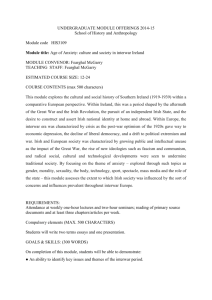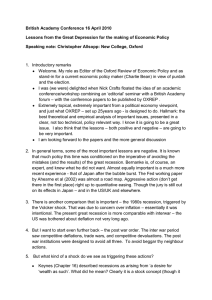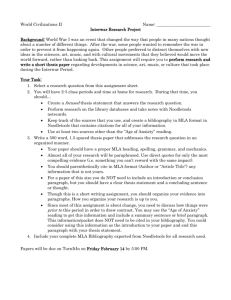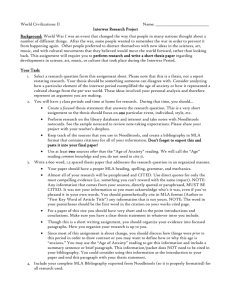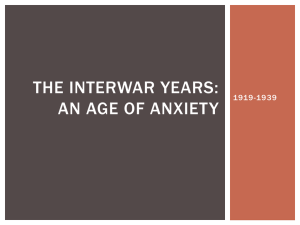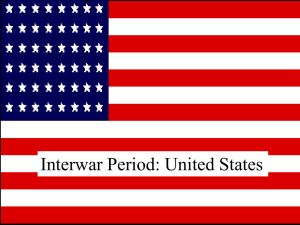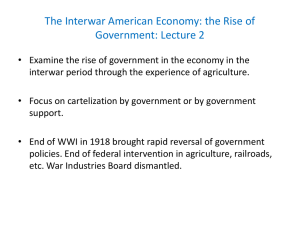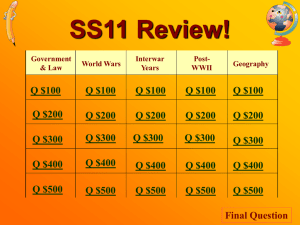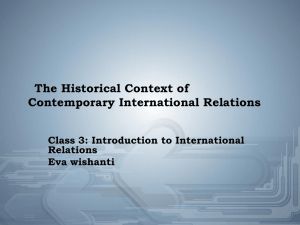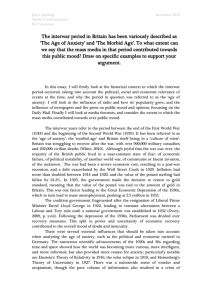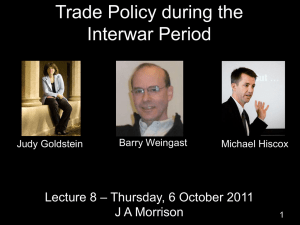Lesson - The Historical Thinking Project
advertisement
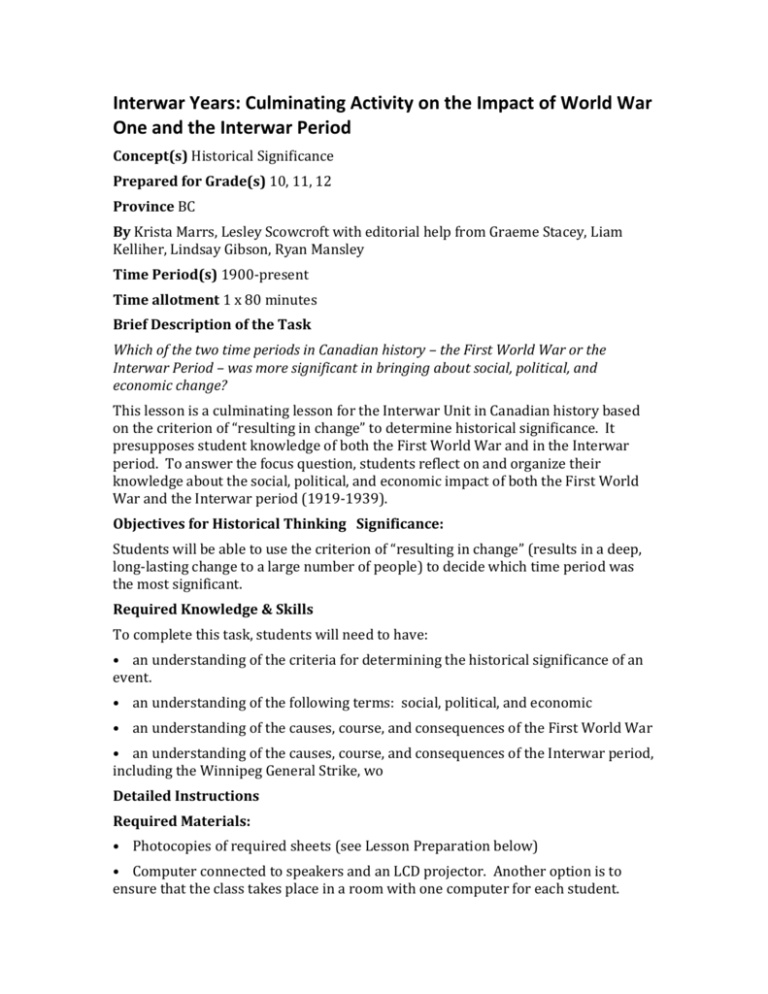
Interwar Years: Culminating Activity on the Impact of World War One and the Interwar Period Concept(s) Historical Significance Prepared for Grade(s) 10, 11, 12 Province BC By Krista Marrs, Lesley Scowcroft with editorial help from Graeme Stacey, Liam Kelliher, Lindsay Gibson, Ryan Mansley Time Period(s) 1900-present Time allotment 1 x 80 minutes Brief Description of the Task Which of the two time periods in Canadian history – the First World War or the Interwar Period – was more significant in bringing about social, political, and economic change? This lesson is a culminating lesson for the Interwar Unit in Canadian history based on the criterion of “resulting in change” to determine historical significance. It presupposes student knowledge of both the First World War and in the Interwar period. To answer the focus question, students reflect on and organize their knowledge about the social, political, and economic impact of both the First World War and the Interwar period (1919-1939). Objectives for Historical Thinking Significance: Students will be able to use the criterion of “resulting in change” (results in a deep, long-lasting change to a large number of people) to decide which time period was the most significant. Required Knowledge & Skills To complete this task, students will need to have: • an understanding of the criteria for determining the historical significance of an event. • an understanding of the following terms: social, political, and economic • an understanding of the causes, course, and consequences of the First World War • an understanding of the causes, course, and consequences of the Interwar period, including the Winnipeg General Strike, wo Detailed Instructions Required Materials: • Photocopies of required sheets (see Lesson Preparation below) • Computer connected to speakers and an LCD projector. Another option is to ensure that the class takes place in a room with one computer for each student. Lesson Sequence This is a culminating activity that assumes students have already learned about World War One and the social, political, and economic trends of the Interwar Period (1919-1939). 1. Hand out ATT 1 “Death and Despair” worksheet to each student. After each student has a copy, introduce the lesson – read the over-riding question students need to keep in mind. (5 minutes) [Note: this attachment is no longer available] 2. Next, introduce or review the definitions of the following terms: social, political, economic. Students will have a copy of the definition on their sheet and they can also add to their examples. Additional relevant examples/explanation to be determined by the teacher. Why are these terms important? Why are they used to organize history? Do you think they are effective “organizers”? (5 minutes) 3. Optional: to refresh students’ memories of World War One, brainstorm using the white board the information students remember. You may wish to refer to Remembrance Day and visit the following site to demonstrate the significance and function of memorials. (5 minutes) Link: http://www.vac-acc.gc.ca/remembers/sub.cfm?source=memorials 4. Optional: to further review World War One and demonstrate the terms, show the following Historica Minutes. After each “minute,” discuss the importance of the event and have students write down the various social, political, and economic circumstances that each episode deals with. These ideas can be written down on the worksheet under the “Example” section for each of the terms. (15 minutes) Minutes to show: A.) Valour Road – Shows courage of Canadians fighting in Belgium in 1915. This discussion can also lead to importance of Ypres. (political, social) Link: http://www.histori.ca/minutes/minute.do?id=10192 B.) Vimy Ridge – Details the battle of Vimy Ridge and nationalism demonstrated by Canadians after victory. (Political, social) Link: http://www.histori.ca/minutes/minute.do?id=14742 C.) Halifax Explosion – Details the Halifax explosion and can lead into greater discussion of direct physical and social effects of the war. (Political, economic, social) Link: http://www.histori.ca/minutes/minute.do?id=10203 D.) John McCrae – Details John McCrae and the writing of In Flanders Fields. Link: http://www.histori.ca/minutes/minute.do?id=10200 (Social) 5. Put students into partners and have students complete the table that outlines the social, political, and economic effects of World War One. **Please see “Alternate Sequence” below (10 minutes) 6. When students are finished discussing the effects of World War One, briefly come together as a class and discuss ideas – try to have each pair contribute to the discussion. Also, ask students about how they would rank the degree of changes brought about by World War One. (5-10 minutes) 7. Have students finish the table for the Interwar Period. Students should refer to previous assignments, notes, discussions to obtain the information for the table. (15 minutes) 8. When students are finished discussing the Interwar Period, briefly go over class ideas together. Teacher should now ask which event was more significant in bringing about change to check for comprehension and ensure students are on the right track. (5-10 minutes) 9. Introduce the “End Task” to the students. Repeat the question and go through the two choices for the assignment given. Reintroduce the definition of a thesis statement (provided on the worksheet). Distribute and discuss the rubric. Finally, ensure students understand what command term, “explain,” means in ATT 2. Place the command terms sheet on the overhead to demonstrate meaning to students. Students could plan ideas for homework and be given time next class to write. 10. Have students plan and complete the assignment. Circulate the classroom to ensure comprehension and expectations with reference to the rubric. **Alternate Sequence: Teachers may wish to review both World War One and the Interwar Period together and then have students complete the full table in partners. If this method is chosen, more time should be given to complete the table and discussion will refer to both events. Outcomes This lesson will address the following Prescribed Learning Outcomes for British Columbia's Social Studies 11. Skills and Processes of Social Studies Apply critical thinking skills, including: comparing, questioning, summarizing, drawing conclusions, defending a position. Demonstrate effective research skills, including: accessing information, assessing information, collecting data, evaluating data, organizing information, presenting information, citing sources. Demonstrate effective written, oral and graphic communication skills, individually and collaboratively. Autonomy and International Development Describe Canada’s evolution as a politically autonomous nation Assess Canada’s role in World War One and the war’s impact on Canada Society and Identity Explain economic cycles with reference to the Great Depression and the labour movement in Canada Assess the development and impact of Canadian social policies and programs related to the [development of] the welfare state
